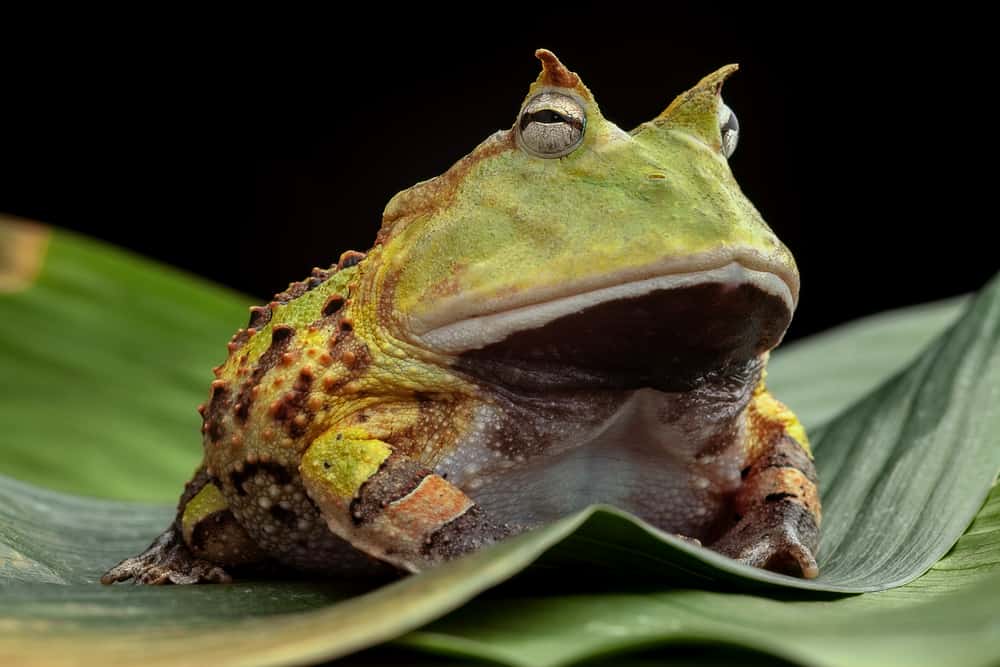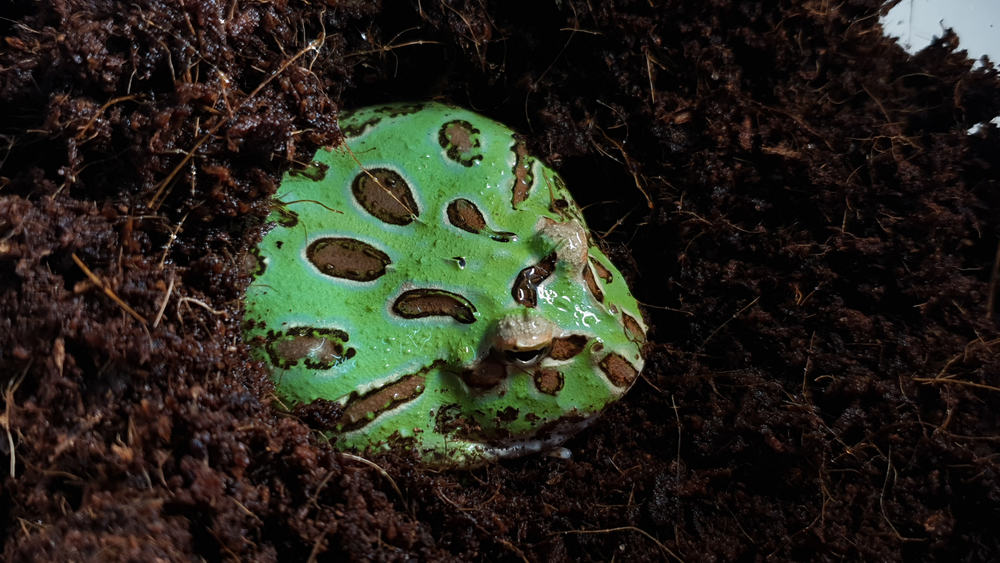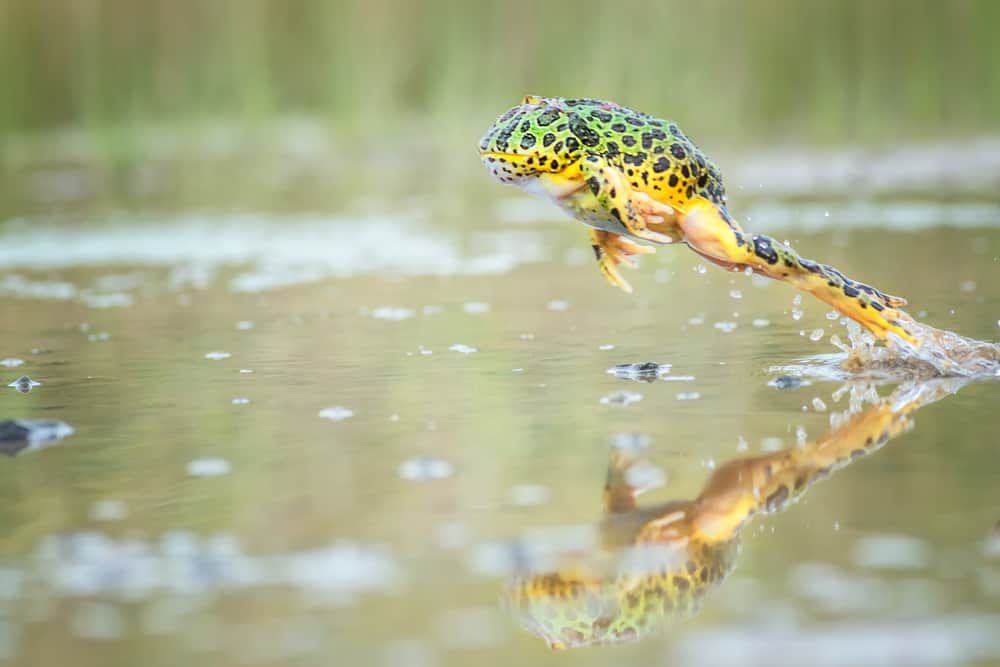Pacman frogs get their name from their round body and large mouth, similar to the famous Pac-Man character. They are also called horned frogs, or South American horned frogs, which refers to their pointy eyelids that look like horns on the top of their head.
Pacman frogs are the most popular pet frogs in the US, and for good reason. They are easy to care for and come in a variety of colors and patterns.
If you’re thinking about getting a pet Pacman frog, it’s important to know what they eat so that you can keep them healthy and provide them with a nutritious diet. But even if you don’t want a Pacman frog as a pet, you might still find it interesting to know what these fascinating creatures eat!
What Do Pacman Frogs Eat?

Pacman frogs eat crickets, earthworms, ants, and many other bugs.
©Dirk Ercken/Shutterstock.com
Pacman frogs eat crickets, earthworms, ants, and many other bugs. Although they are usually classified as insectivores, they are also opportunistic carnivores and will consume fish, small mammals, reptiles, other amphibians, and even small birds if they can catch them.
People who own Pacman frogs as pets provide them with crickets or roaches as the main staple of their diet, with the occasional fish, earthworm, or pinkie mouse as a special treat.
A Complete List of Foods Pacman Frogs Eat
Pacman frogs are generalist ambush predators, meaning they will sit, wait, ambush, and eat any animal that crosses their path and fits in their mouth.
Their varied diet can include animals such as:
- Crickets
- Grasshoppers
- Worms
- Ants
- Beetles
- Roaches
- Spiders
- Snails
- Centipedes
- Caterpillars
- Butterflies
- Frogs
- Snakes
- Lizards
- Mice
- Birds
Like other frogs and toads, Pacman frogs swallow their prey whole. This means they can only eat animals that are small enough to fit in their mouth. If they try to eat something that is larger than their large gape, they will choke on it and may even die.
Do Pacman Frogs Eat Other Pacman Frogs?
Yes, Pacman frogs will, in some cases, eat smaller Pacman frogs. This typically only happens during certain environmental conditions in which normal feeding behaviors are difficult.
For example, if there are too many amphibians and not enough prey animals in the local environment, larger Pacman frogs may cannibalize smaller frogs. This eliminates potential competition for food and may help to balance the local ecosystem by preventing prey insects from becoming overeaten to the point of extinction.
How Do Pacman Frogs Hunt and Eat?

Pacman frogs will hide and wait to ambush their unsuspecting prey.
©Nidal Haiqal/Shutterstock.com
Pacman frogs are nocturnal ambush predators. This means they will sit nearly motionless for long periods of time, often hiding in leaves or another substrate, waiting for an unsuspecting animal to cross their path.
When an animal does wander close enough, the Pacman frog will use its long sticky tongue to quickly snag the animal and pull it into its mouth. Then their big strong jaws will clamp down and prevent them from escaping. They’ll swallow their prey whole, bones and all, and their stomach acids will break down the animal so it can be fully digested.
How Much Should I Feed My Pet Pacman Frog?

Pacman frogs are colorful, low-maintenance pets that are easy to feed.
©Valt Ahyppo/Shutterstock.com
Feed your pet Pacman frog live insects 2-3 times per week. Young frogs may require daily feeding.
In most cases, 3-4 crickets will be enough, though you should keep an eye on your frog to see how much it is actually eating and if it is too skinny or too fat. If they haven’t consumed all of the crickets by the next morning, you are likely giving them more than they need.
It is generally recommended that you should regularly dust your pet frog’s insects with a vitamin and mineral supplement since they won’t be getting the same varied diet they would in the wild. This is especially important for younger, growing frogs who only get a few different types of food.
If you choose to give your pet Pacman mice to feast on, only do so once every 2 or 3 weeks. These mice are very fattening and should only be given as an occasional treat.
Why Is My Pet Pacman Frog Not Eating Right?
Significant changes in appetite typically indicate something is wrong with your Pacman frog. If your frog suddenly stops eating or starts eating much less than normal, it could be sick. In most cases, illnesses in pet Pacman frogs are related to their diet and feeding habits.
Common illnesses include:
- Metabolic bone disease: This is caused by a lack of nutrient supplementation in the diet and results in fragile, deformed bones. You may notice a drooping jaw or an inability to hold onto prey.
- Corneal lipidosis: A high-fat diet (eating too many mice, for example) can cause a fatty film to form over the frog’s eyeballs, eventually leading to impaired vision.
- Ingestion of non-food items: Pacman frogs will sometimes try to eat things that aren’t food, like pebbles, sticks, or decorative items. These can potentially cause severe digestive blockages.
- Toxic out syndrome: If your pet frog is jumping erratically or abnormally stretching out its hind legs, it may have been exposed to something toxic. Their skin is very delicate and sensitive, so this usually happens if they sit in dirty water or if they have been handled with unclean hands.
- Parasitic infection: If a Pacman frog eats an insect that is already infected with parasites, those parasites can end up in the frog’s digestive system. This can lead to a wide range of problems, including weight loss, malnutrition, and death.
If your pet Pacman frog does not return to its normal eating habits after a few days, take it to the vet for a checkup.
Do Pacman Frogs Hibernate?
Pacman frogs will sometimes go through a type of hibernation called estivation. This usually happens as a survival mechanism if they are too hot or too cold.
The frog will bury itself underground and enter a state of dormancy. Its metabolism will slow down, and it will eat much less. The frog should eventually emerge when the conditions are more favorable.
The ideal temperature for most Pacman frogs is 75 to 85 degrees Fahrenheit. If your pet Pacman is kept in an enclosure that is not the right temperature, this may be another potential reason why it is not eating in its normal way.
Why Are Pacman Frogs Important to Our Ecosystem?

Pacman frogs help to keep our waterways healthy.
©muhamad mizan bin ngateni/Shutterstock.com
As tadpoles, Pacman frogs eat algae and other aquatic plants. This prevents the overgrowth of these plants, which can choke out other aquatic life. In this way, Pacman frogs help to keep our waterways healthy.
As adults, Pacman frogs eat a variety of insects and pests. This includes harmful insects that can damage crops or carry diseases. By preventing these populations from growing too large, Pacman frogs help to protect us from potential disease and crop loss.
Pacman frogs are an important part of the food chain. They are prey for a variety of animals, including snakes, birds, bears, and monkeys. This helps to keep these larger animals healthy and provides a source of food for them.
Pacman frogs can also be useful for researchers because of how susceptible they are to changes in their environment. Since their skin is very sensitive, they can easily absorb chemicals and pollutants from their surroundings. If there is something wrong with their environment, Pacman frogs will usually be the first to show signs of it. This makes them valuable as an early warning indicator for environmental problems.
Without Pacman frogs, the whole food chain that they are a part of would be thrown off balance—our waterways could become choked with plants, pests would overpopulate, causing crop damage and potentially spreading disease, and larger animals would lose an important food source. So, even though they might seem small and insignificant, Pacman frogs play a big role in keeping our ecosystem healthy.
The photo featured at the top of this post is © Valt Ahyppo/Shutterstock.com
Thank you for reading! Have some feedback for us? Contact the AZ Animals editorial team.






